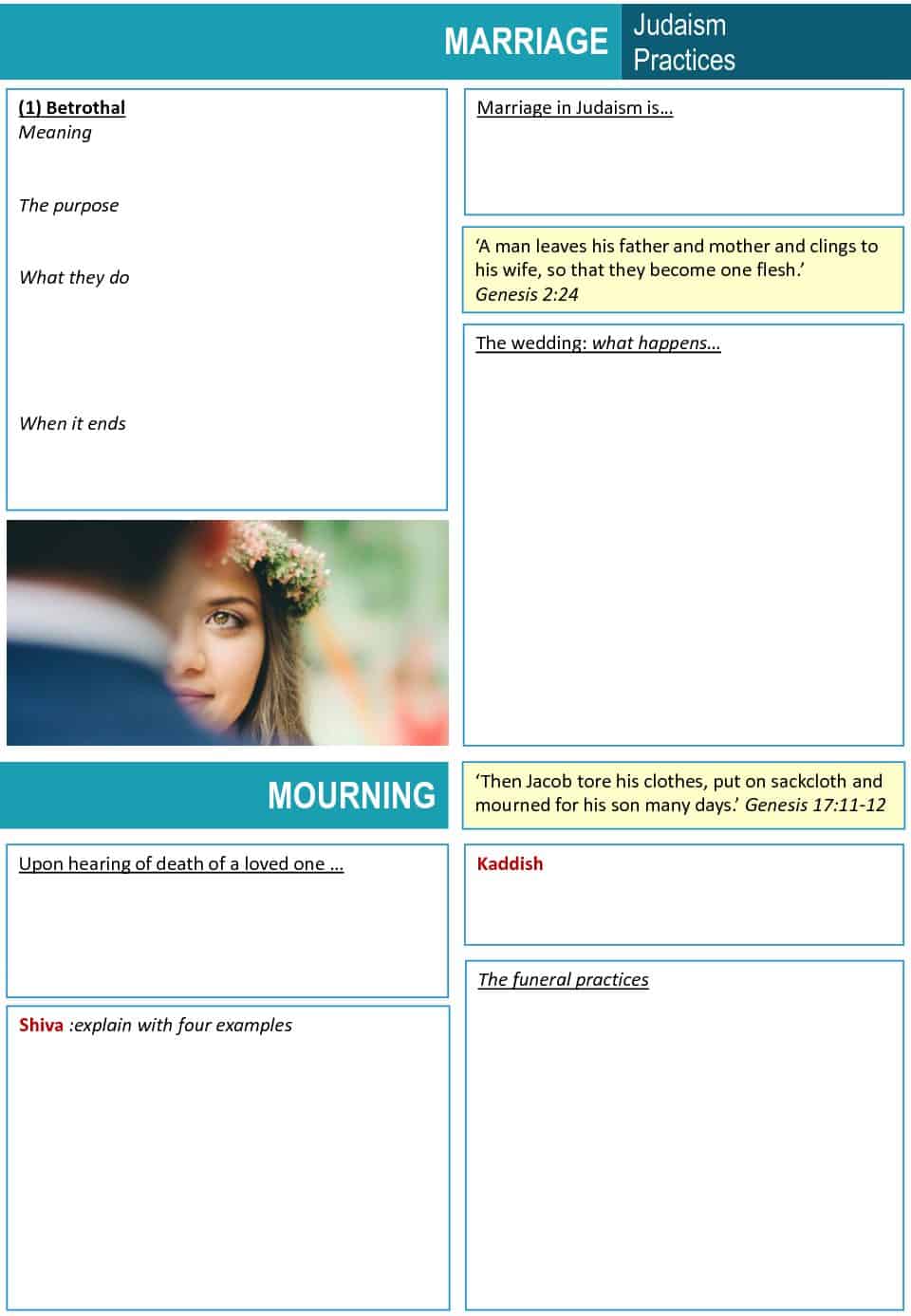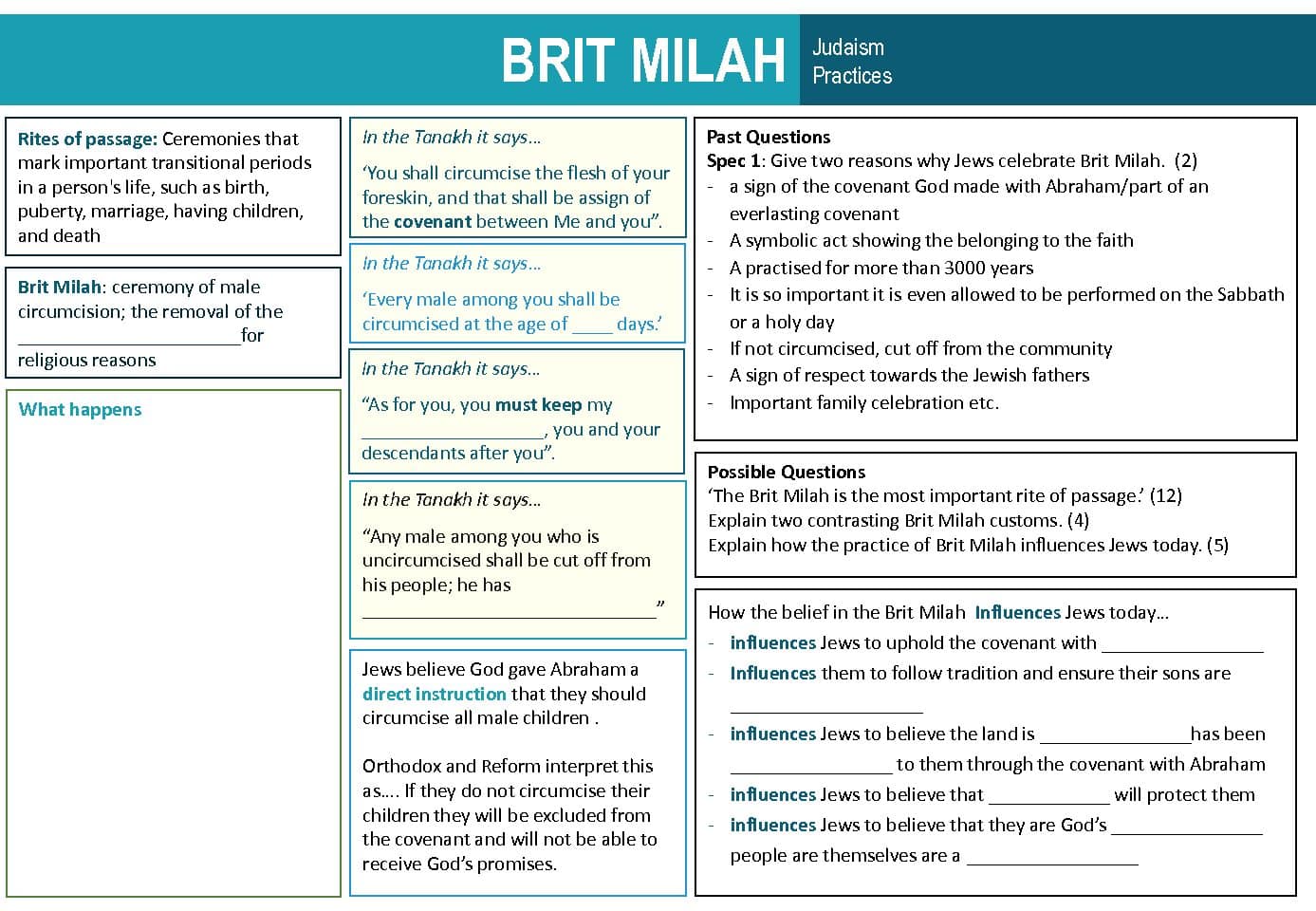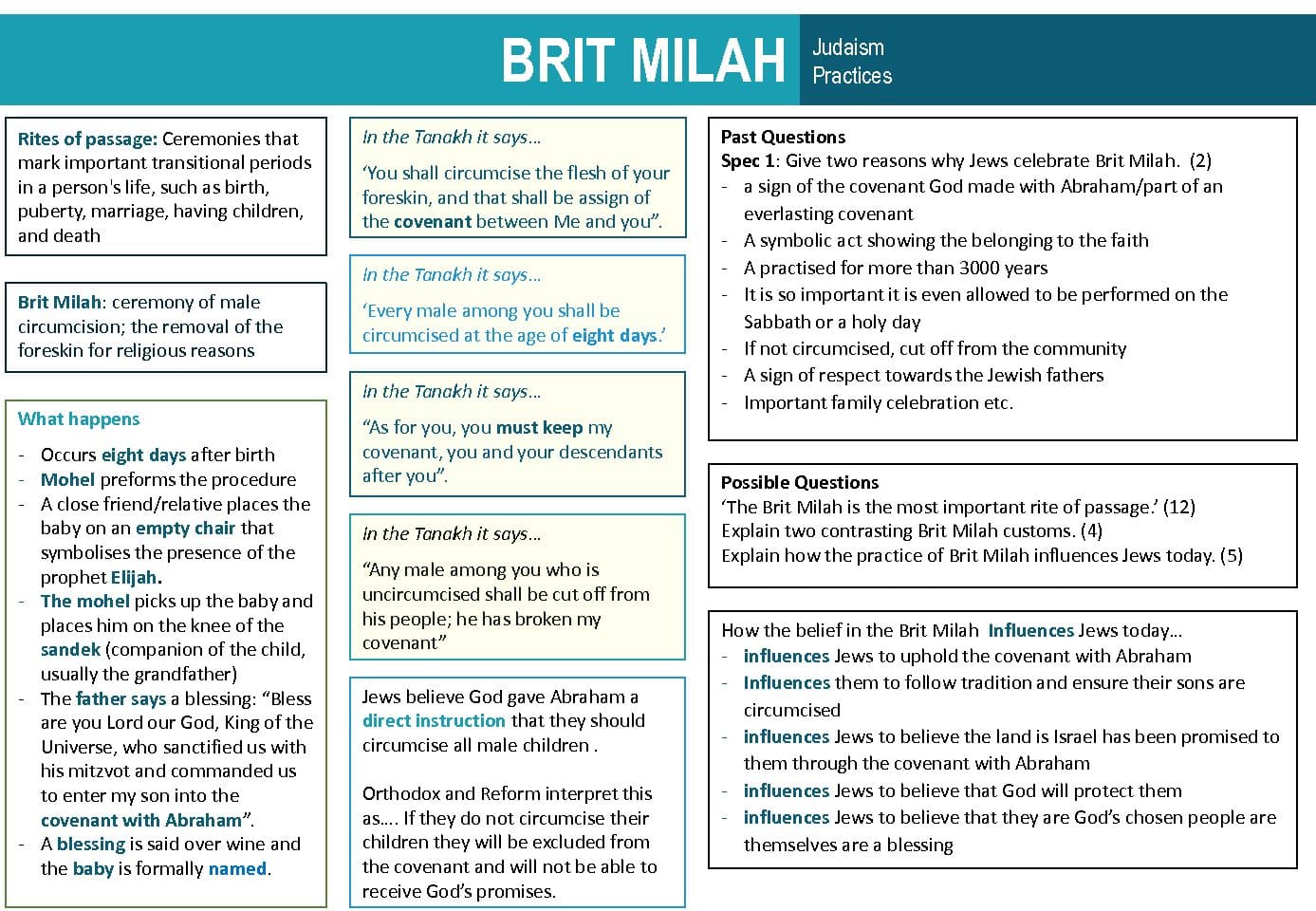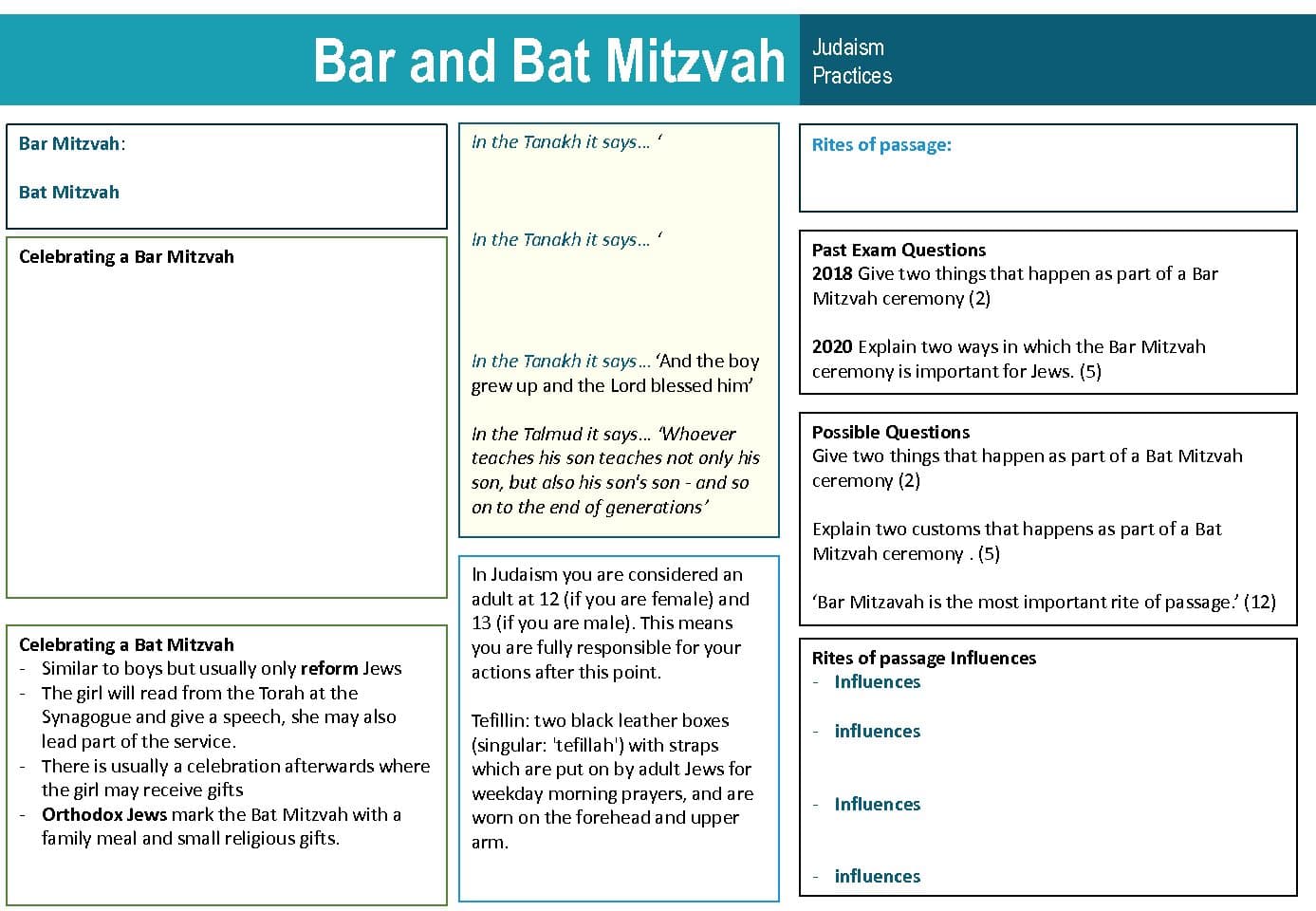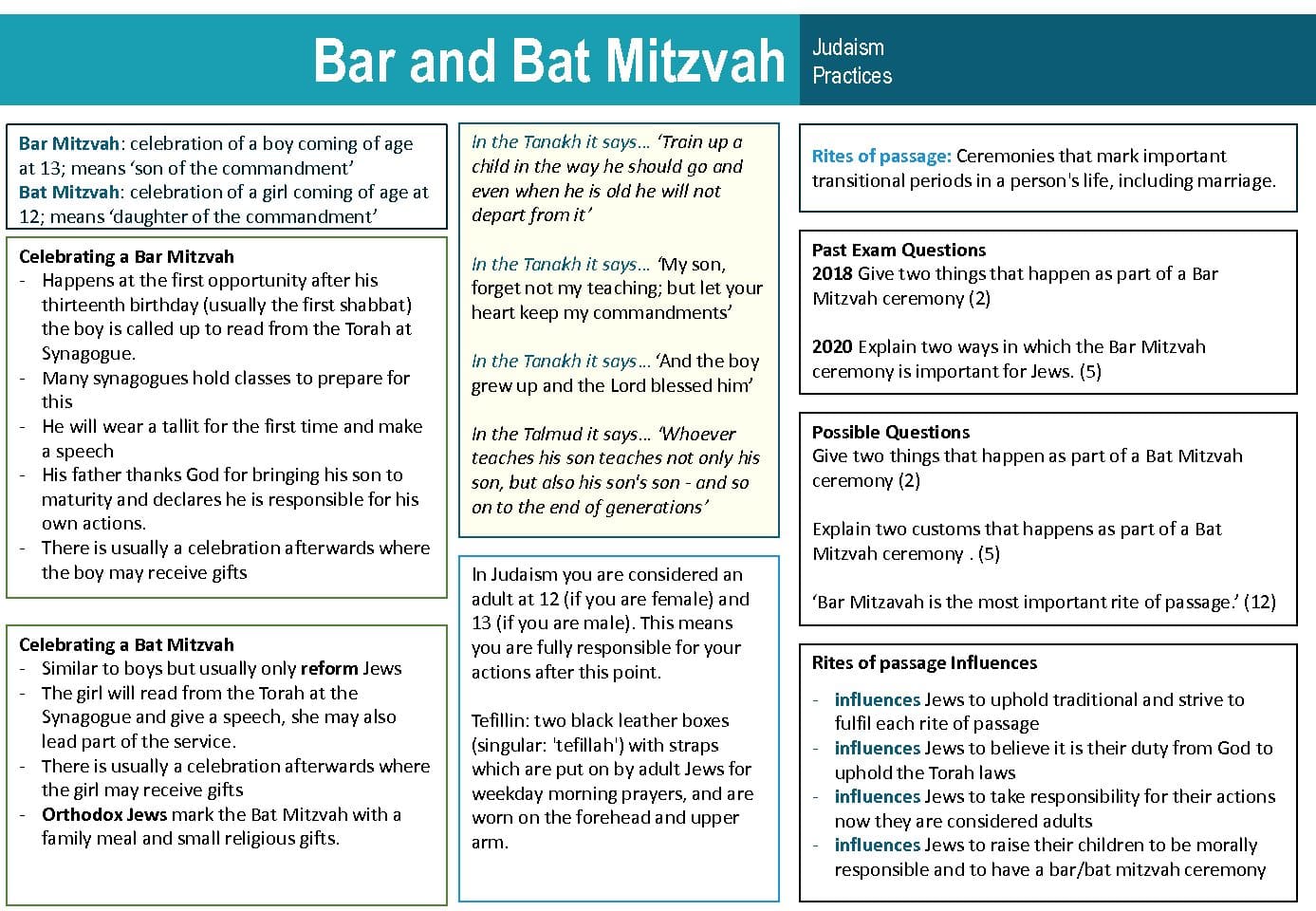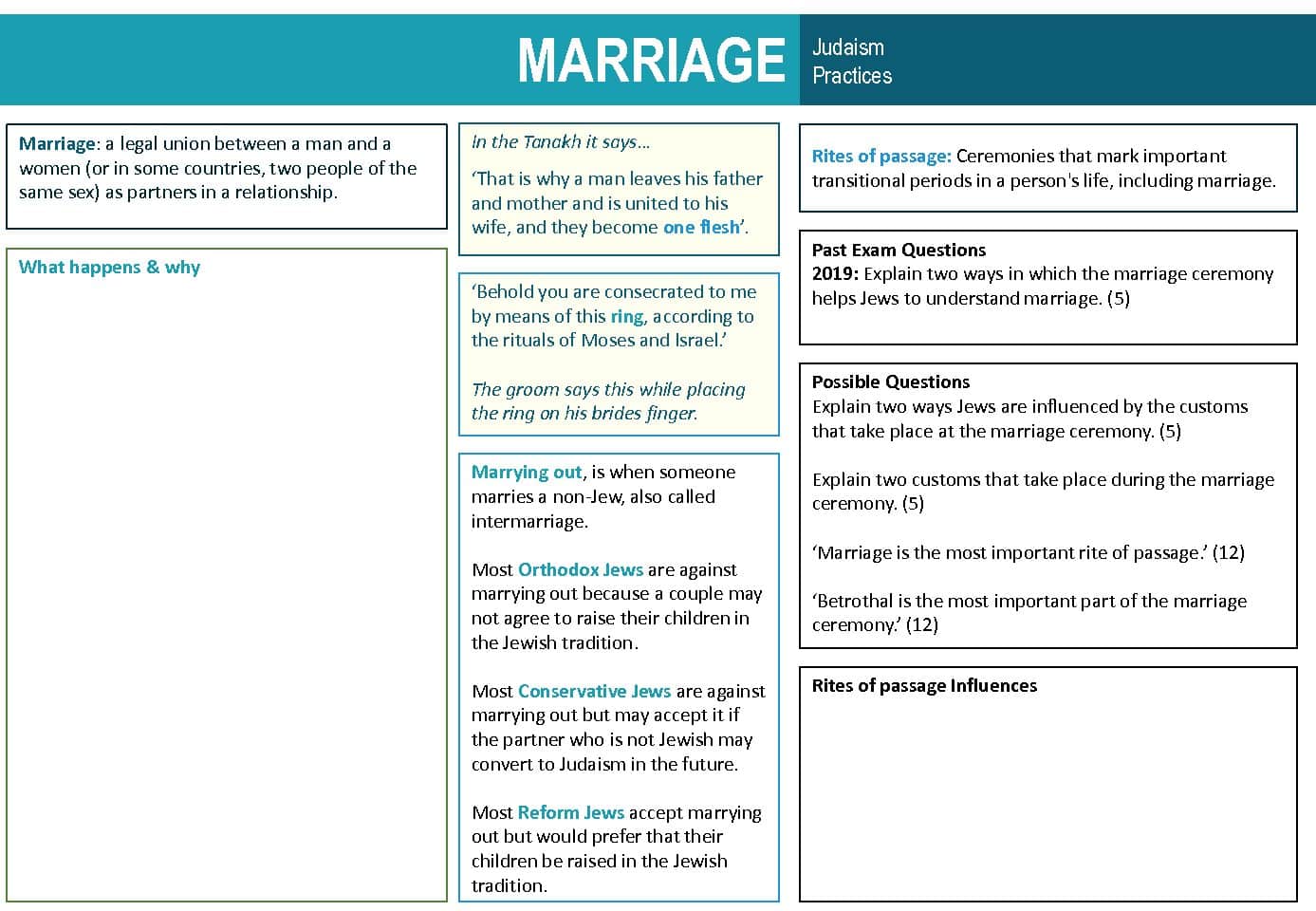Judaism Practices
Rites of passage
Rituals and their significance
- ceremonies associated with birth including Brit Milah
- Bar and Bat Mitzvah
- the marriage ceremony
- mourning rituals.
Birth
Give two reasons why Jews celebrate Brit Milah. (2)
Spec 1
A symbolic act showing the belonging to the faith/practised for more than 3000 years/a sign of the covenant God made with Abraham/part of an everlasting covenant/so important it is even allowed to be performed on the Sabbath or a holy day –/if not circumcised, cut off from the community/a sign of respect towards the Jewish fathers/important family celebration etc.
Bar & Bat Mitzvah
Give two things that happen as part of a Bar Mitzvah ceremony. (2)
2018
- The boy puts on the tephillin and tallit
- the boy is called up to say the blessings over the Torah, (his first aliyah)
- boys may read from the Torah / chant the weekly prophetic portion (haftarah)
- lead some or all of the congregational service
- and offer a personal interpretation of the weekly Torah portion (d’var Torah)
- throwing of sweets
- the boy may make a speech
- the rabbi may offer a blessing
- the father thanks God for releasing him from his spiritual obligations for his son
- can pray as part of the minyan
- celebration
- small gifts etc.
N.B. Focus on the ceremony rather than the significance
Explain two ways in which the Bar Mitzvah ceremony is important for Jews. (5)
2020
- Ceremony represents the start of a boy taking full responsibility for his own religious education and development / the boy will have had to prepare thoroughly for his Bar Mitzvah / he will have studied the Torah in preparation for reading out loud in the synagogue / he will have spent many hours learning how to read and recite Hebrew / he will have prepared a speech on a theme in the
Torah / and may have also developed a community project / this will have helped him to understand that he is a scholar of the Torah and that this will continue into his adult life / and that he has responsibilities to the wider Jewish community. - Following the ceremony, he will now be able to show full and proper respect when praying / as he will be able to correctly wear the tallit and tefillin / Deuteronomy 6:8 ‘You shall bind them as a sign upon your hand, and they shall be a reminder between your eyes’.
- Completion of the ceremony provides another person who is now eligible to make up a minyan / when a minyan meets, Shekhinah is present / minyan required for specific acts of worship, eg funeral / means there is another person who can read the Torah in the synagogue during worship.
- The ceremony celebrates the link in an unbroken chain of thousands of years of Jewish tradition / the boy is joining this tradition to claim his own Jewish identity and show personal desire for links to whole of Judaism.
- The ceremony is a reminder of freedom to live as a practising Jew / reminder of all those denied this privilege / reminder of being one of God’s chosen people.
- Ceremony involves whole community / community is very important in Judaism / becoming Bar Mitzvah is an extension of that sense of community / initiation to full community / now seen as one of the adults.
- Important day for whole family / extended family attend even from far away / as well as public acknowledgement and celebration within the community, etc.
Marriage
Explain two ways in which the marriage ceremony helps Jews to understand marriage. (5)
2019
- A Jewish wedding takes place under the chuppah, a canopy held up by four poles / this symbolises the home they will build together / but also has open sides to remind them that the Jewish community will support them and play a part in their marriage / and that their home should also be welcoming to visitors. The chuppah also demonstrates the fragility of relationships and the need to support them
- At a Jewish wedding the bride may wear white as a symbol of sexual purity / Jews are expected to save the gift of sexual relations for marriage / Jewish couples are expected to
have children (the fifth of the seven blessings)
• At the start of the ceremony the groom may perform bedeken which is the unveiling of the bride / (Rebecca veils herself as she is told that Isaac is approaching: Genesis 24:64) / this is a reminder of the groom’s love for his bride and her inner beauty - The bride may circle the groom three to seven times / sometimes both partners circle each other / some believe this to be a sign of protection, against temptation and the glances of others / others see this as the formation of a new family circle. The ring is placed on the bride’s finger / and the groom says ‘Behold you are consecrated to me with this ring, according to the Law of Moses and Israel’ / this means that the couple’s relationship has sanctity and is blessed by God / the relationship is lifelong / Genesis 2:24, husband and wife become ‘one flesh’ / the ring has objective value which symbolises the value of the relationship
- In the Orthodox tradition, the Ketubah is signed / this reminds the groom that he has responsibilities towards his wife / and any children that they may go on to have in the progressive tradition, the ketubah include both partners’ responsibilities
- Blessings are recited / these are to remind the couple of the joy they will share / as a celebration of the power of love / blessings are also said for joy, peace and companionship.
- A glass is broken beneath the groom’s foot / this reminds those present of the destruction of the Temple / it reminds them that although they are joyful this day, they could be even more joyful if they could fulfil the commandments which depend on the Temple, etc.
Mourning
Explain two contrasting Jewish mourning rituals practised when someone has died. (4)
2021
- When Jews first hear of the death, parents will make a small tear in the clothes over their heart, other close relatives on the right side of their chest / a blessing is said (‘Blessed are You, Lord, our God, King of the Universe, the True Judge’).
- The first part of mourning (Aninut) is most intense / close family grieve / do not have to follow certain religious rules / ensure someone stays with the body until burial / recite psalms constantly / cannot cut their hair / cannot wash their clothes / cannot bathe / no sexual relations / cannot wear tefillin / lasts until burial takes place.
- Once the burial has taken place, a meal of condolence (bread and eggs – new life) is prepared by a close friend or relative.
- Shiva (7 days of intense mourning) starts after the burial / mourners stay at home / sit on low stools / wear no leather shoes, do not shave or cut their hair / cover their mirrors / no make-up / do not work / pray three times a day at home with minyan of ten friends or relatives / the kaddish is recited.
- Lesser period of mourning (Sheloshim) follows shiva and lasts until 30 days after death / life returns to normal but no music, parties, shaving or haircut / male mourners say the kaddish daily in the synagogue.
- Final period of mourning (Avelut) lasts for 11 months after the lesser period / mourners do not attend parties / children say the kaddish if it is their parent who has died.
- Some have a ceremony of unveiling the headstone of the grave once mourning has ended / visitors may place a small stone on the headstone / sons mark the anniversary of a parent’s death by saying the kaddish and possibly making a Torah blessing.
- Differences between ways Orthodox and Reform Jews mourn eg some Reform Jews may sit shiva for 3 days rather than 7 / rather than tear their clothes, a Reform rabbi may give torn black ribbons to the mourners to pin on their clothing, etc.
‘Jewish mourning rituals are needed for the living more than for the dead.’ (12)
2020
Arguments in support
- Rituals help the mourners come to terms with their loss / mourners are at their most vulnerable/lost at this time / so in greatest need.
- Whole community comes together to support the family in their time of need / such as preparing all food for them in the first week (Shiva) / community focus is on the living / community support those left behind / which shows recognition of greater need / as only small number attend to needs of deceased.
- Blessings (berakhot) for the bereaved – May God comfort you among all those who mourn for Zion and Jerusalem / praying to support the mourners.
- When a person dies / those left behind feel sadness and loss / they think about the deceased and what they were / whereas it is not possible to know whether the dead need anything at all / the dead are gone so have no needs / whereas it is obvious that the bereaved have need.
- The dead are dead and gone / anything those left behind do is for their own satisfaction or comfort / or out of obligation to their name, etc.
Arguments in support of other views
- ‘Need’ is the wrong word / dead are given respect through the whole process / are the focus of any actions/rituals.
- Special rituals for the dead / volunteer group (Chevra Kadisha, literally ‘sacred society’) prepare the body in a precise way / singing of hymns beside body to comfort the soul / body not left alone before burial / as it is not known when the soul departs / all for the benefit of the dead person / these are given primacy.
- At grave, attendees often have to put soil into the grave / departure from graveside is through two lines of mourners from the community to say words of mourning / intended to show respect to the dead person / suggests graveside rituals are more for the dead than the living / as they are focused on the deceased.
- Period of mourning lasts a year for the children / close family / many prohibitions in shiva (first week after burial) / including no study of Torah, no work, sit low, cover mirrors / for next 11 months (avelut) may not attend happy events, must go to synagogue for all services / intention is to keep them mindful of their loss, show appropriate respect / this is all caused by having had a death in the family / so the dead person is the centre of everything, and the cause of everything.
- By definition, mourning is about the dead / the dead and the mourners are two sides of the same coin / so mourning rituals cannot be seen as being about one rather than the other, etc.
Resources
Videos






